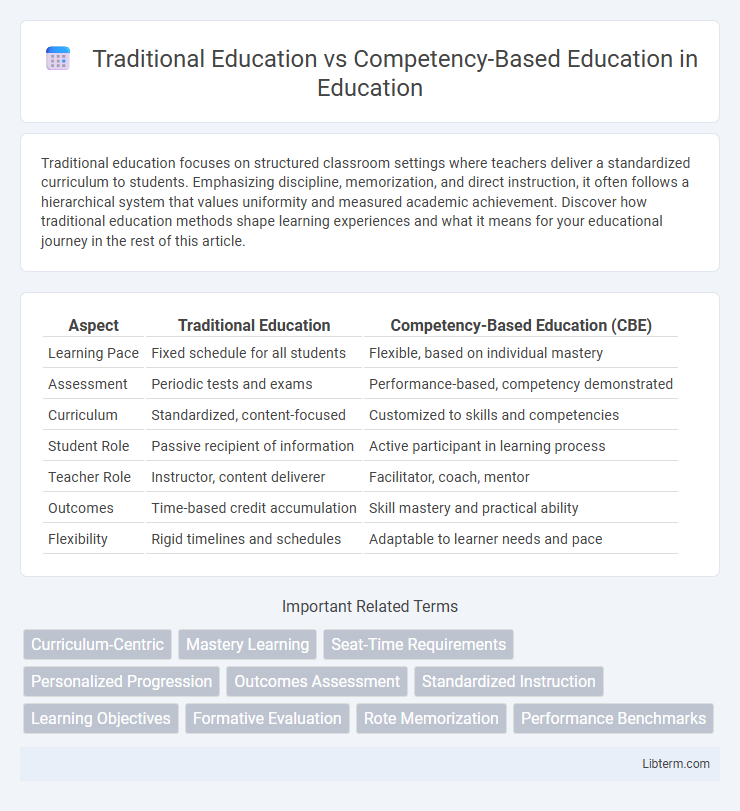Traditional education focuses on structured classroom settings where teachers deliver a standardized curriculum to students. Emphasizing discipline, memorization, and direct instruction, it often follows a hierarchical system that values uniformity and measured academic achievement. Discover how traditional education methods shape learning experiences and what it means for your educational journey in the rest of this article.
Table of Comparison
| Aspect | Traditional Education | Competency-Based Education (CBE) |
|---|---|---|
| Learning Pace | Fixed schedule for all students | Flexible, based on individual mastery |
| Assessment | Periodic tests and exams | Performance-based, competency demonstrated |
| Curriculum | Standardized, content-focused | Customized to skills and competencies |
| Student Role | Passive recipient of information | Active participant in learning process |
| Teacher Role | Instructor, content deliverer | Facilitator, coach, mentor |
| Outcomes | Time-based credit accumulation | Skill mastery and practical ability |
| Flexibility | Rigid timelines and schedules | Adaptable to learner needs and pace |
Introduction to Traditional and Competency-Based Education
Traditional education relies on time-based learning structures where students progress through set curricula at a fixed pace, often focused on theoretical knowledge acquisition. Competency-based education emphasizes mastery of specific skills and outcomes, allowing students to advance based on demonstrated competencies rather than time spent in class. This approach fosters personalized learning paths and practical skill application aligned with workforce demands.
Historical Evolution of Educational Models
Traditional education, rooted in the industrial era, emphasizes uniform curricula, age-based progression, and standardized assessments. Competency-Based Education (CBE) emerged in the late 20th century, shifting focus to mastery of skills and personalized learning paces, driven by technology and workforce demands. The evolution reflects a transition from content delivery to learner-centered approaches prioritizing measurable outcomes and real-world competencies.
Core Principles of Traditional Education
Traditional education centers on structured curriculum delivery, emphasizing time-based progression through grade levels and standardized assessments to measure student performance. It prioritizes teacher-led instruction and uniform content coverage, aiming to build foundational knowledge across subjects within fixed academic schedules. This model relies heavily on memorization and repetition, reinforcing discipline and consistency in the learning process.
Key Features of Competency-Based Education
Competency-Based Education (CBE) emphasizes mastery of specific skills and knowledge at an individualized pace, allowing learners to progress after demonstrating competence rather than spending fixed time in class. Key features include personalized learning pathways, clear and measurable learning outcomes, and continuous assessment strategies designed to validate student proficiency. This approach contrasts traditional education by prioritizing learner-centered progress and real-world application over seat time and standardized grading.
Curriculum Structure and Learning Outcomes
Traditional education follows a fixed curriculum structure with standardized courses and time-based progress, emphasizing theoretical knowledge acquisition. Competency-Based Education (CBE) allows flexible pacing, where students advance upon mastering specific skills and competencies, enabling personalized learning paths. Learning outcomes in traditional education are often uniform and grade-focused, while CBE prioritizes demonstrable skills and practical application, leading to more tailored and measurable student performance.
Assessment Methods: Exams vs. Mastery
Traditional education relies heavily on standardized exams to assess students' knowledge at fixed intervals, often emphasizing rote memorization and time-based progression. Competency-based education prioritizes mastery of specific skills and concepts, using assessments that allow learners to demonstrate understanding through practical application and personalized pacing. This approach ensures students advance only after proving competency, fostering deeper learning and real-world readiness.
Student Engagement and Motivation
Traditional education often relies on fixed curricula and standardized testing, which can limit student engagement by emphasizing rote memorization over critical thinking. Competency-based education enhances motivation by allowing students to progress at their own pace, mastering skills before moving forward, fostering a deeper sense of achievement and relevance. Research shows that personalized learning paths in competency-based models significantly increase student participation and intrinsic motivation compared to traditional methods.
Teacher Roles and Instructional Approaches
In traditional education, teachers primarily serve as knowledge transmitters delivering standardized curricula through lectures and assessments focused on memorization and grades. Competency-based education shifts the teacher's role to a facilitator and coach, guiding personalized learning paths that emphasize mastery of specific skills and real-world applications. Instructional approaches in competency-based models utilize formative assessments and adaptive feedback to ensure learners achieve proficiency before advancing, contrasting with the time-based progression typical of traditional classrooms.
Benefits and Challenges of Each Model
Traditional education offers structured curricula with clear timelines and standardized assessments, providing consistency and ease of credentialing but may limit individualized pacing and real-world skill application. Competency-based education emphasizes mastery of specific skills and knowledge at the learner's own pace, fostering personalized learning and practical competency but can face challenges in standardization and scalability. Balancing these models requires addressing traditional education's rigidity and competency-based education's implementation complexities to optimize learning outcomes.
Future Trends in Education: Blending Traditions and Competencies
Future trends in education emphasize blending traditional education methods with competency-based education (CBE) to enhance personalized learning and skill mastery. Integrating hands-on experiential learning from traditional models with CBE's focus on measurable outcomes supports the development of critical thinking and real-world problem-solving skills. Emerging technologies like AI and adaptive learning systems facilitate this fusion by providing tailored learning pathways that respect foundational knowledge while promoting competency achievement.
Traditional Education Infographic

 libterm.com
libterm.com